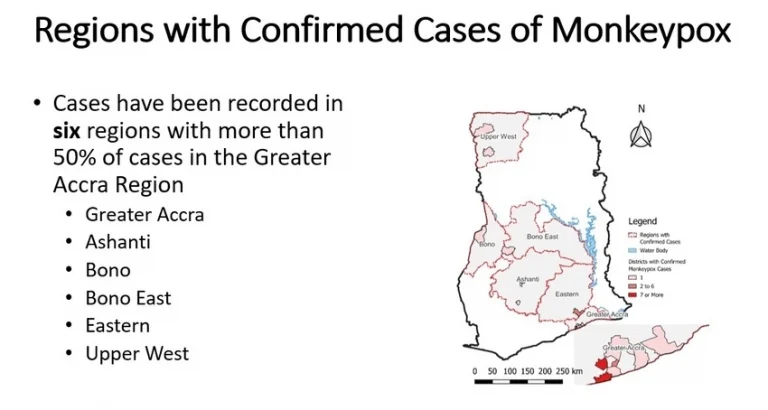
The overall number of confirmed monkeypox cases in Ghana has now reached 34, with cases identified in six areas. More than half of all monkeypox cases in Ghana are in the Greater Accra Region.
Greater Accra, Ashanti, Bono, Bono East, Eastern, and Upper West are the regions where cases have been discovered, according to the Ghana Health Service (GHS).
The World Health Organization classified the monkeypox epidemic as a worldwide Public Health Emergency of International Concern (PHEIC) on Saturday (July 23, 2022). (WHO).
The designation is the highest level of warning that the WHO can issue and comes in the wake of a worldwide increase in cases.
It occurred at the conclusion of the WHO’s emergency committee on the virus’s second meeting.
The final verified occurrence in Ghana occurred on July 15th, 2022, with ages ranging from 9 months to 45 years.
According to the GHS, no fatalities have been reported in the cases, with the majority of patients being male.
Dr Patrick Kuma-Aboagye, Director General of the GHS, stated at a press conference in Accra on Sunday [July 24, 2022] that District Rapid Response Teams and Case Management Teams have been trained on Monkeypox Outbreak Response Measures, and that dissemination of WHO Preliminary Guidelines on Case Management is underway.
The GHS is performing assessments in impacted localities, contact tracing and follow-up, and enhanced education in schools and communities in partnership with the Veterinary Services Department.
Concerning the prognosis, Dr. Kuma-Aboagye stated that Ghana’s public health system is under strain due to a number of public health issues and that the risk of widespread Monkeypox cases remains but does not constitute a significant threat.
He noted that the threat of Marburg virus disease transmission persists but is minimal, and that adherence to protocols and infection prevention and control techniques, as well as increased ongoing surveillance operations, remain critical for early diagnosis and sufficient containment.
Unlike previous occasional instances connected to travel to endemic regions, health officials have not determined the source of infection in the current outbreak, which is predominantly focused in Europe.

Human-to-human transmission occurs when people come into close physical contact, and the recent surge in cases connected to sexual interaction suggests that the virus associated to the disease can be spread sexually.
The current outbreak emphasises the importance of vigilant safe sexual practices and suggests that monkeypox can be transmitted while the infected person exhibits few or no symptoms; however, the risk is currently rated as low for individuals who do not engage in multiple or anonymous sexual partners on a regular basis.
Monkeypox does not occur naturally in Ghana; most instances are documented in West and Central Africa, particularly in the Democratic Republic of the Congo, Nigeria, and Cameroon among people who have had contact with wild monkeys or other mammals that may house the illness. The most recent confirmed monkeypox epidemic in Ghana was in 2003.
Monkeypox is caused by a virus that is related to the virus that causes smallpox.
Monkeypox, on the other hand, is not the same as smallpox and does not have the same capability for fast human-to-human transmission.
Monkeypox is mostly spread to humans through direct contact with diseased rodents or primates’ body fluids. Close personal contact with an infected individual via respiratory droplets, direct touch with body fluids, or indirect contact with lesion material is the primary mode of human-to-human transmission (e.g., contaminated clothing or bedding).
Symptoms usually manifest 6–16 days after exposure, however, they might appear up to 21 days later. Fever, headache, muscular pains and backaches, enlarged lymph nodes, chills, tiredness, and a unique rash marked by lesions that move through multiple stages before dropping off are common symptoms.
In countries where monkeypox is being transmitted, public health officials have advised the use of basic health precautions such as frequent handwashing with soap and water, covering the nose and mouth when coughing, and avoiding obviously ill individuals, in addition to avoiding overcrowded areas such as nightclubs, and considering using safe sexual practices such as physical barriers (condoms). If symptoms appear within two weeks of being in impacted areas, get medical assistance.